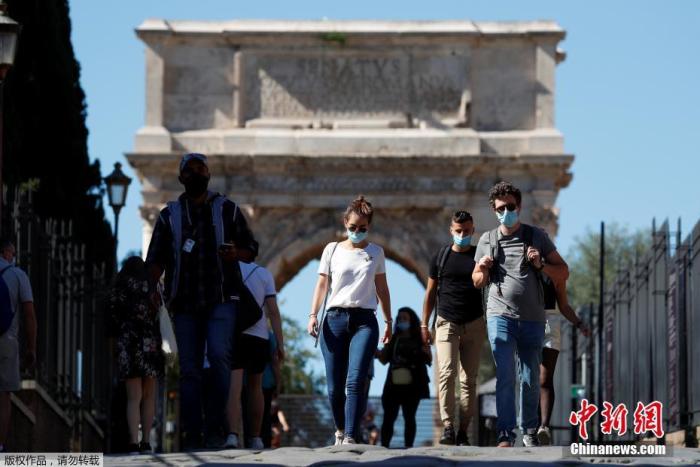China News Service, October 20. According to Euronet, citing EUN News Agency, on the evening of the 18th local time, Italian Prime Minister Conte issued the latest anti-epidemic decree, authorizing the regional government to impose curfew and blockade measures on areas in need.
Once the decree was promulgated, it caused dissatisfaction among some local government officials. Conte then called cabinet ministers for emergency consultations to revise the relevant provisions of the epidemic prevention decree, which was formally promulgated and implemented on the 19th.
The decree is valid until November 13.
On October 8, local time, in Rome, the capital of Italy, people wearing masks were walking near the Colosseum.
According to reports, according to the revised anti-epidemic laws and regulations, restaurants, bars and other catering businesses are open from 5 a.m. to midnight, and can only provide table service from 18:00 p.m., allowing businesses to continue to provide takeaway and package services.
The catering industry in public places such as highways, airports, hospitals, and gas stations remains open.
Relevant laws and regulations involving schools will be implemented from the 21st, which will allow high school schools to remain open and appropriately adjust school hours to avoid traffic peaks.
In areas with severe epidemics, high schools can choose to mix teaching with centralized teaching and distance education, while primary and secondary schools and kindergartens remain open.
The revised anti-epidemic decree did not mention the most controversial issue concerning the power to decide on the implementation of curfew and quarantine measures.
In response, some Italian local government officials stated that they refused to accept the authorization of the central government.
The president of the Italian National Association of Mayors and the mayor of Bari de Canro pointed out that it is an unacceptable decision for the Italian central government to delegate the power to decide on curfew and blockade measures to local governments.
In the fight against the new crown epidemic, all government functional departments, including local governments, should assume their responsibilities.
Florence Mayor Nardella stated that the central government's authorization to local governments is too general and has not clarified under which circumstances curfew and blockade measures should be adopted.
Rome Mayor Raj pointed out that local governments lack sufficient data and information, law enforcement capabilities, relevant legal support and public support for curfew and blockade measures.
During the implementation process, unexpected resistance will be encountered and it is difficult to achieve the expected results.
According to the report, the Italian central government previously authorized the regional government to implement lockdown measures, and now continues to expand local autonomy for epidemic prevention, allowing provincial and municipal governments to deal with curfews and blockades on their own.
This move will inevitably bring tremendous pressure to the elected local officials, causing local officials to directly face criticism from the public and lose their support.
Italian Minister of Regional and Autonomous Regions Boccia said that the cabinet has amended relevant legal provisions based on the opinions of local government officials.
However, any city needs to implement curfew and blockade measures, and the mayor must make a decision and assume relevant responsibilities.
Boca pointed out that the central government authorized local governments to exercise the right to impose curfews and blockades, and it did not directly shift the responsibility for fighting the epidemic to local governments.
Expanding the autonomy of local governments to prevent epidemics aims to further improve epidemic prevention policies and measures that are in line with local actual conditions, because local governments have a better understanding of the actual conditions of the region.
According to reports, the epidemic report data issued by the Italian Ministry of Emergency Civil Defense showed that as of 18:00 local time on the 19th, there were 9,338 new confirmed cases of new crown in Italy, and a total of 423,578 confirmed cases; 73 new deaths and a total of 36,616 deaths.
(Boyuan)

